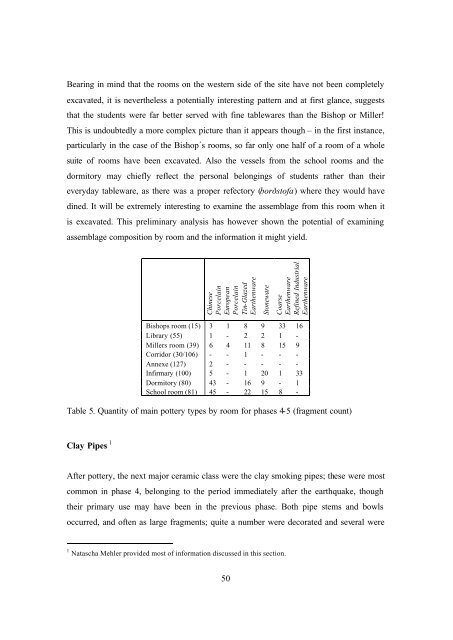Skáholt 2002 - Nabo
Skáholt 2002 - Nabo
Skáholt 2002 - Nabo
Create successful ePaper yourself
Turn your PDF publications into a flip-book with our unique Google optimized e-Paper software.
Bearing in mind that the rooms on the western side of the site have not been completely<br />
excavated, it is nevertheless a potentially interesting pattern and at first glance, suggests<br />
that the students were far better served with fine tablewares than the Bishop or Miller!<br />
This is undoubtedly a more complex picture than it appears though – in the first instance,<br />
particularly in the case of the Bishop´s rooms, so far only one half of a room of a whole<br />
suite of rooms have been excavated. Also the vessels from the school rooms and the<br />
dormitory may chiefly reflect the personal belongings of students rather than their<br />
everyday tableware, as there was a proper refectory (borðstofa) where they would have<br />
dined. It will be extremely interesting to examine the assemblage from this room when it<br />
is excavated. This preliminary analysis has however shown the potential of examining<br />
assemblage composition by room and the information it might yield.<br />
Chinese<br />
Porcelain<br />
European<br />
Porcelain<br />
Tin-Glazed<br />
Earthenware<br />
Stoneware<br />
Coarse<br />
Earthenware<br />
Refined Industrial<br />
Earthenware<br />
Bishops room (15) 3 1 8 9 33 16<br />
Library (55) 1 - 2 2 1 -<br />
Millers room (39) 6 4 11 8 15 9<br />
Corridor (30/106) - - 1 - - -<br />
Annexe (127) 2 - - - - -<br />
Infirmary (100) 5 - 1 20 1 33<br />
Dormitory (80) 43 - 16 9 - 1<br />
School room (81) 45 - 22 15 8 -<br />
Table 5. Quantity of main pottery types by room for phases 4-5 (fragment count)<br />
Clay Pipes 1<br />
After pottery, the next major ceramic class were the clay smoking pipes; these were most<br />
common in phase 4, belonging to the period immediately after the earthquake, though<br />
their primary use may have been in the previous phase. Both pipe stems and bowls<br />
occurred, and often as large fragments; quite a number were decorated and several were<br />
1 Natascha Mehler provided most of information discussed in this section.<br />
50
















